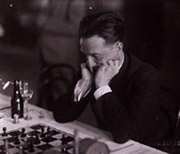Chiharu Shiota

1. The Thread“In 1992, I used threads for the first time,” says Shiota. “I was studying painting then, and used the black wool for drawing in the air … If I weave something and it turns out to be ugly, twisted, or knotted, then such must have been my feelings when I was working.”
2. The LatticeworkIn terms of shape, Shiota finds triangles to be most effective. “A line is too clear,” she says, “too visible. Triangles upon triangles become complicated, hiding some things from the eye.” Her webs are not unlike the intricate rope systems used in Japanese gardening to shield trees from snowfall. “When I walk in the park and look at trees in the wintertime it always seems like my work,” she says. “It looks similar, but has a different meaning.”
3. The RelicsFor the German Waiting, the burned chairs came from a girls’ school built in 1902; these, which Shiota wanted to be “more neutral,” came from Bushwick’s Green Village Used Furniture & Clothing, a.k.a. Sidney’s. The concept harks back to a childhood memory of a neighbor’s burning house. “The chairs have no function, but their existence is stronger than before. They are still waiting for someone to sit down.”
4. The Corner SpaceUsing a corner of the exhibition space has prompted much art-world discussion in the past, as it’s considered difficult to manage. (An entire exhibition at Andrea Rosen last month was devoted to corners.) Though the Freiburg version of Waiting is positioned in the center of the gallery, Shiota chose a corner here to create the illusion of depth and to establish distance between work and audience.
5. The Charring“In Berlin, Chiharu just made a pile of chairs outside of her apartment, burned them in the street. It was no big deal,” says Mike Egan, director of operations at Goff + Rosenthal, who helped fabricate the piece. “If I tried to do that here, the FDNY would probably take me out.” Egan blackened this group of chairs safely away from the city, at a friend’s ranch upstate.
6. The Onsite WorkWorking with one assistant, Shiota spent two and a half days completing Waiting. Her process of gluing, knotting, and tacking down threads is often regarded as performative in nature. As Berlin curator Steffi Goldmann has said, “Perhaps her production is sustained by a desire to contain her own inner perturbation and her often overpowering anxiety.”










